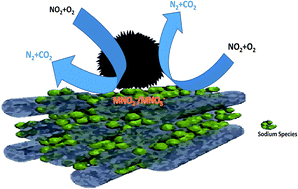当前位置:
X-MOL 学术
›
J. Mater. Chem. A
›
论文详情
Our official English website, www.x-mol.net, welcomes your
feedback! (Note: you will need to create a separate account there.)
Surface sodium functionalization of ordered mesoporous Co3O4 controls the enhanced simultaneous catalytic removal of soot and NOx
Journal of Materials Chemistry A ( IF 10.7 ) Pub Date : 2017-09-04 00:00:00 , DOI: 10.1039/c7ta03071a Zhi Jiang 1, 2, 3, 4 , Zhixin Zhu 1, 2, 3, 4 , Weiqi Guo 1, 2, 3, 4 , Mingxia Chen 1, 2, 3, 4 , Wenfeng Shangguan 1, 2, 3, 4
Journal of Materials Chemistry A ( IF 10.7 ) Pub Date : 2017-09-04 00:00:00 , DOI: 10.1039/c7ta03071a Zhi Jiang 1, 2, 3, 4 , Zhixin Zhu 1, 2, 3, 4 , Weiqi Guo 1, 2, 3, 4 , Mingxia Chen 1, 2, 3, 4 , Wenfeng Shangguan 1, 2, 3, 4
Affiliation

|
Nanocasting is a common strategy for creating nanostructured porous materials. The last step of the nanocasting process is the removal of the hard template to obtain the final replica. Here using Co3O4 as a model catalyst for the simultaneous soot–NOx removal reaction, we illustrate that the silica mold removal step, using hot sodium hydroxide (NaOH) or dilute hydrofluoric acid (HF) solutions, will significantly influence the final catalytic activity. Ordered mesoporous Co3O4 using HF to remove the template (m-Co3O4–F) exhibited slightly higher activity over bulk Co3O4 synthesized by the sol–gel method (b-Co3O4–S). While mesoporous Co3O4 obtained with a similar process using NaOH (m-Co3O4–Na) exhibited excellent activity in soot combustion and NOx reduction. The yield of N2 for m-Co3O4–Na was almost twice the amount of b-Co3O4–S. Experimental results reveal that NOx is stored as unstable nitrate species over m-Co3O4–Na due to the existence of homogeneous sodium species introduced by the removal process, hence favoring the oxidation of soot and reduction of NOx. This result not only highlights the importance of the NO reaction pathway in the simultaneous soot–NOx removal reaction but also affords a facile route to functionalize mesoporous oxide surface properties by varying the removal procedures, which unlocks strategies to optimize other reactions employing mesoporous materials synthesized by the nanocasting method.
中文翻译:

有序介孔Co 3 O 4的表面钠官能化控制了烟灰和NO x的同时催化去除的增强
纳米浇铸是制造纳米结构多孔材料的常用策略。纳米铸造过程的最后一步是去除硬模板以获得最终的复制品。这里以Co 3 ø 4作为用于同时烟灰-NO模型催化剂X除去反应中,我们说明的是,二氧化硅模具去除步骤中,使用热氢氧化钠(NaOH)或稀释的氢氟酸(HF)溶液,将显著影响最终催化活性。有序介孔Co 3 O 4使用HF去除模板(m-Co 3 O 4 –F)显示出比本体Co 3 O 4稍高的活性通过溶胶-凝胶法(b-Co 3 O 4 -S)合成。而介孔钴3 ö 4与使用NaOH(米-钴类似的方法得到3 ö 4 -Na)在烟灰燃烧表现出优异的活性和NO X还原。m-Co 3 O 4 -Na的N 2产率几乎是b-Co 3 O 4 -S的两倍。实验结果表明,NO x以不稳定的硝酸盐形式存储在m-Co 3 O 4之上-Na由于通过去除过程中引入的,因此,有利于烟灰和还原的氧化的NO均匀钠物种的存在X。这一结果不仅突出了NO的反应途径的重要性在同时烟灰NO X脱除反应也得到了容易路线通过改变拆卸步骤,其中解锁策略来优化使用中孔材料的其他反应合成官能化的中孔氧化物的表面特性通过纳米浇铸法。
更新日期:2017-09-22
中文翻译:

有序介孔Co 3 O 4的表面钠官能化控制了烟灰和NO x的同时催化去除的增强
纳米浇铸是制造纳米结构多孔材料的常用策略。纳米铸造过程的最后一步是去除硬模板以获得最终的复制品。这里以Co 3 ø 4作为用于同时烟灰-NO模型催化剂X除去反应中,我们说明的是,二氧化硅模具去除步骤中,使用热氢氧化钠(NaOH)或稀释的氢氟酸(HF)溶液,将显著影响最终催化活性。有序介孔Co 3 O 4使用HF去除模板(m-Co 3 O 4 –F)显示出比本体Co 3 O 4稍高的活性通过溶胶-凝胶法(b-Co 3 O 4 -S)合成。而介孔钴3 ö 4与使用NaOH(米-钴类似的方法得到3 ö 4 -Na)在烟灰燃烧表现出优异的活性和NO X还原。m-Co 3 O 4 -Na的N 2产率几乎是b-Co 3 O 4 -S的两倍。实验结果表明,NO x以不稳定的硝酸盐形式存储在m-Co 3 O 4之上-Na由于通过去除过程中引入的,因此,有利于烟灰和还原的氧化的NO均匀钠物种的存在X。这一结果不仅突出了NO的反应途径的重要性在同时烟灰NO X脱除反应也得到了容易路线通过改变拆卸步骤,其中解锁策略来优化使用中孔材料的其他反应合成官能化的中孔氧化物的表面特性通过纳米浇铸法。











































 京公网安备 11010802027423号
京公网安备 11010802027423号